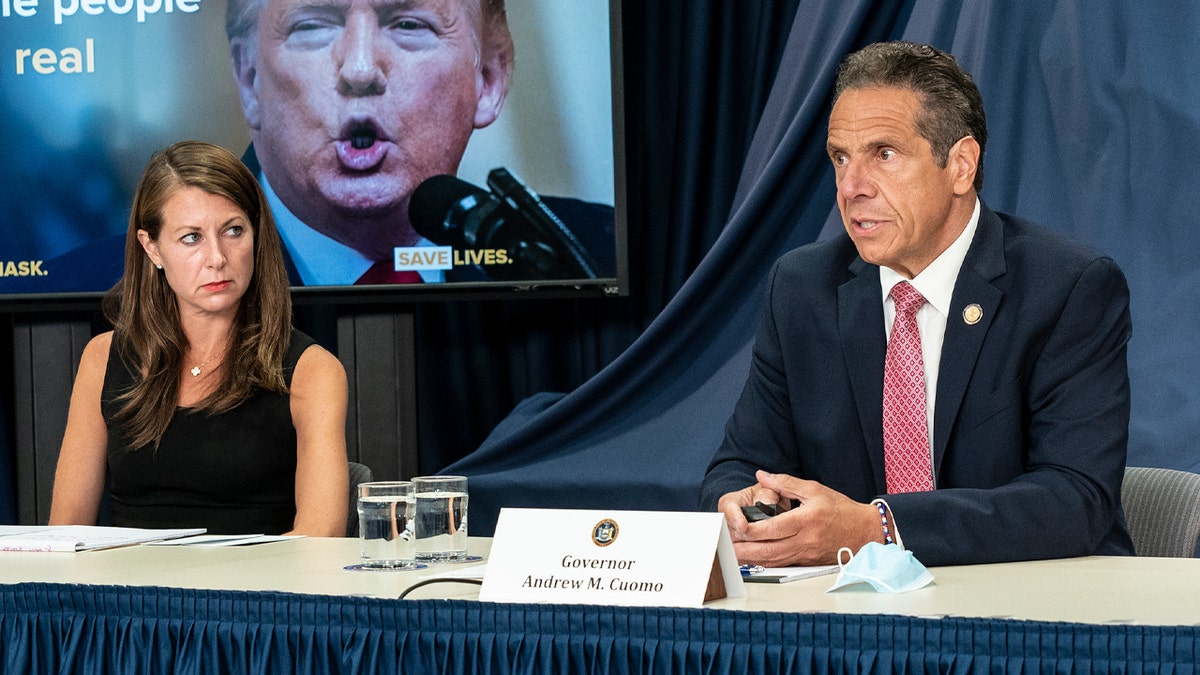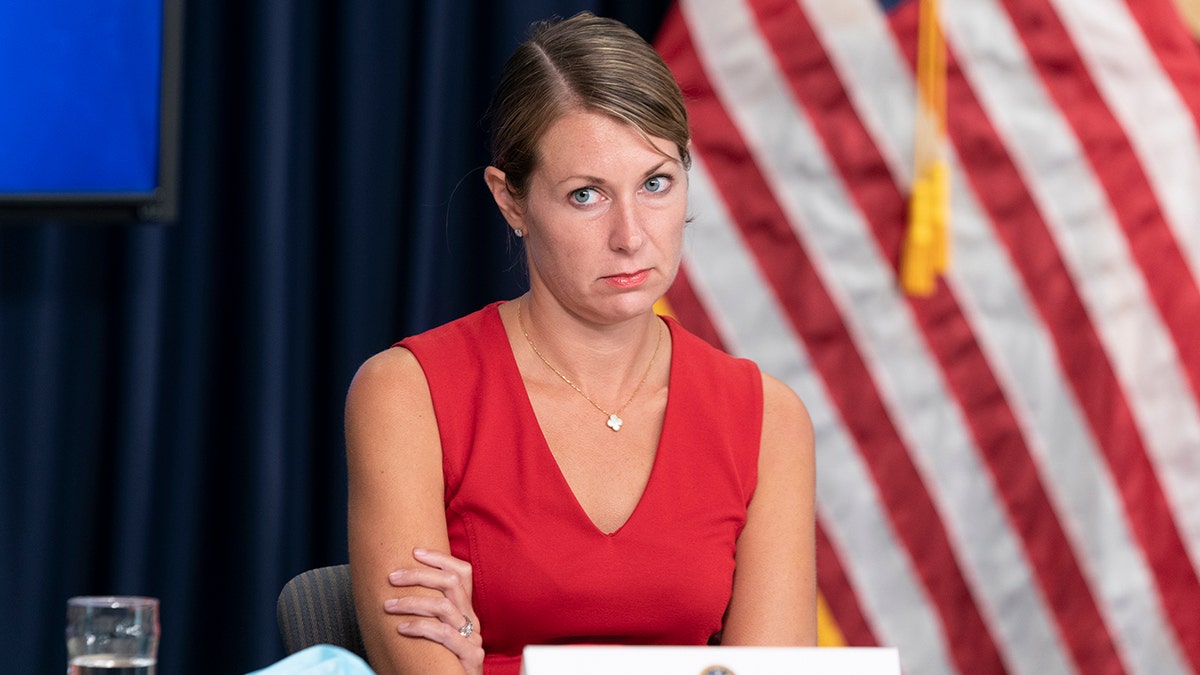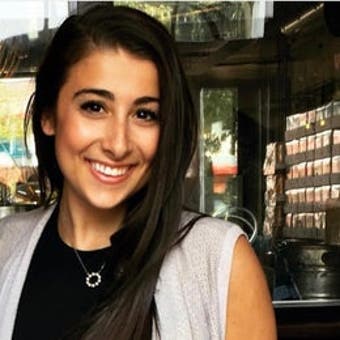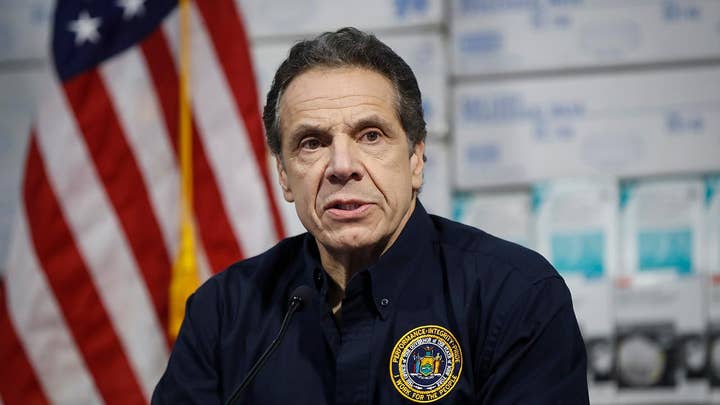Cuomo pressured to resign over nursing home report
A top aide to New York Gov. Andrew Cuomo tells leading state Democratic lawmakers that the administration had reportedly withheld data on COVID-19 deaths at nursing homes to avoid federal scrutiny; Laura Ingle reports.
A bombshell report released late Thursday described how New York Gov. Andrew Cuomo's office withheld data about the state's handling of the novel coronavirus in nursing homes.
Secretary to the Governor Melissa DeRosa, his top aide, revealed during a recent conference call that the Cuomo administration hid unfavorable information about the state’s nursing home COVID-19 deaths out of concern that it "was going to be used against us," the New York Post first reported.
Speaking to Democratic leaders during a recent conference call, DeRosa said the governor’s office officials "froze" after then-President Donald Trump turned the pandemic into "a giant political football" and began tweeting about the state’s shoddy handling, according to the report.
CUOMO AIDE TELLS NY DEMOCRATS ADMINISTRATION HID NURSING HOME DATA TO KEEP IT FROM TRUMP DOJ: REPORT

Secretary to Governor Melissa DeRosa and NYS Governor Andrew Cuomo as he makes an announcement and holds media briefing at 3rd Avenue office. (Photo by Lev Radin/Pacific Press/LightRocket via Getty Images)
"He starts tweeting that we killed everyone in nursing homes," DeRosa reportedly said. "He starts going after [New Jersey Gov. Phil] Murphy, starts going after [California Gov. Gavin] Newsom, starts going after [Michigan Gov.] Gretchen Whitmer."
Trump then instructed the U.S. Department of Justice to investigate the state’s response, she continued.
"And basically, we froze," she reportedly said. "Because then we were in a position where we weren’t sure if what we were going to give to the Department of Justice, or what we give to you guys, what we start saying, was going to be used against us while we weren’t sure if there was going to be an investigation."
She reportedly added: "That played a very large role into this."

Melissa DeRosa Secretary to Governor attends Andrew Cuomo announcement that restaurants can be open for in-door dining on September 30 at 3rd ave office. (Photo by Lev Radin/Pacific Press/LightRocket via Getty Images)
According to the Post, DeRosa asked the group for "a little bit of appreciation of the context."
"So we do apologize," she said, according to the report. "I do understand the position that you were put in. I know that it is not fair. It was not our intention to put you in that political position with the Republicans."
She released a public statement on Friday, in which she tried to clarify her statements and wrote: "I was explaining that when we received the DOJ inquiry, we needed to temporarily set aside the Legislature’s request to deal with the federal request first. We informed the houses of this at the time."
"We were comprehensive and transparent in our responses to the DOJ, and then had to immediately focus our resources on the second wave and vaccine rollout," she said, in part. "As I said on the call with legislators, we could not fulfill their requests as quick as anyone would have liked."
But many have called for further investigation -- and even prosecution -- by New York Attorney General Letitia James and the DOJ.
It's not the first time the Cuomo administration's handling of COVID-19 in nursing homes has come under fire by the public and officials across the aisle.
As noted by reports and Grabien Media founder Tom Elliott, for months, Cuomo deflected the blame on other people -- such as nursing home staff -- or defended his office by claiming the Empire State was doing better than others in protecting its most vulnerable.
Data released in late January showed New York may have undercounted the number of COVID-19 deaths at nursing homes by more than 50%, solidifying previously reported concerns regarding the Empire State’s pandemic response at such facilities.
A 76-page report released by James’ office on Jan. 28 found New York State may have undercounted COVID-19 deaths among nursing home residents by thousands – backing up the findings of an Associated Press investigation last year that focused on the fact that New York is one of the only states in the nation that count residents who died on nursing home property and not those who later died in hospitals.
The method of counting allowed Cuomo to boast that his state had a lower percentage of nursing home deaths compared to other states.
But such an undercount would have meant the state’s official tally of 8,711 nursing home deaths to the virus was actually more than 13,000, boosting New York from No. 6 to highest in the nation.
"While we cannot bring back the individuals we lost to this crisis, this report seeks to offer transparency that the public deserves," Attorney General Letitia James said in a statement.
Cuomo later told reporters that "everybody did the best they could."
State Health Commissioner Dr. Howard Zucker said Friday it was "inaccurate" for the report to describe the number of deaths as being "undercounted."
NEW YORK NURSING HOME DEATHS TOPPED 12K, CUOMO HEALTH CHIEF REVEALS
"It’s not about pointing fingers or blame, it’s that this became a political football, right?" Cuomo noted during the press conference. "Look, whether a person died in a hospital or died in a nursing home … people died. People died. … By the way, the same people are dying today."
AP’s analysis in August concluded that the state could be undercounting deaths by as much as 65%, based on discrepancies between its totals and numbers being reported to federal regulators. That analysis was, like James’ report, based on only a slice of data, rather than a comprehensive look.
James’ investigators looked at a sample of 62 of the state’s roughly 600 nursing homes. They reported 1,914 deaths of residents from COVID-19, while the state Department of Health logged only 1,229 deaths at those same facilities. One unnamed facility, for example, had an official death toll of 11 but the attorney general’s probe found that 40 had actually died.
NY UNDERCOUNTED NURSING HOME CORONAVIRUS DEATHS BY AS MUCH AS 50%, STATE AG SAYS
The report from James, a fellow Democratic official, undercut Cuomo’s frequent argument that the criticism of his handling of the virus in nursing homes was part of a political "blame game," and it was a vindication for thousands of families who believed their loved ones were being omitted from counts to advance the governor’s image as a pandemic hero.
MARCH – APRIL 2020
The first COVID-19 case reported in New York at the beginning of March 2020 and the state quickly grew to be a hotspot in the country.
On March 25, Cuomo’s administration enacted a policy that sought to create more space in hospitals by releasing recovering COVID-19 patients into nursing homes.
The AP investigation found that hospitals around the state released more than 4,500 recovering coronavirus patients to nursing homes under the directive, which prohibited nursing homes from refusing to take in patients because they had or may have had COVID-19.
James’ report said those admissions "may have contributed to increased risk of nursing home resident infection and subsequent fatalities," and noted that at least 4,000 nursing home residents with COVID-19 died after that guidance. But the report said the issue would require further study to conclusively prove such a link.
MAY 2020
Cuomo’s office announced on May 10 that patients being moved from a hospital to a New York nursing home must first test negative for COVID.
The governor’s office also said from March 1 to May 1, more than 4,800 people in New York nursing homes died from COVID-19, accounting for approximately 25% of all New York deaths.
NURSING HOME CORONAVIRUS: DO FAMILIES HAVE LEGAL RECOURSE?
After a flood of criticism regarding the March 25 directive, Cuomo was asked in mid-May if he had a comment for families who are seeking accountability and felt as though they had been failed.
He responded: "How do we get justice for those families? Who can we prosecute for those deaths? Nobody. Mother Nature, God, where did this virus come from? People are going to die by this virus. That is the truth."
"Older people, vulnerable people, are going to die from this virus," Cuomo added. "That is going to happen despite whatever you do, with all our progress as a society, we can't keep everyone alive. Older people are more vulnerable. That is a fact that is not going to change."
The reporter followed up by saying some people felt that the negative test mandate enacted that month could have prevented deaths, to which Cuomo responded: "People rationalize death in different ways."
He added: "I don't think there is any logical rationale to say they would be alive today."
JUNE 2020
Speaking to NBC’s "Meet the Press" on June 28, Cuomo said he’s "taken political heat," and people should not be pointing fingers at New York over its nursing home response. He the criticism to politics, rather than facts, according to a transcript of the interview.
"In New York, we’re number 46 in the nation in terms of percentage of deaths at nursing homes, compared to the total percentage," he said, referencing data released by the New York Times. "It's been unfortunate in every state and we have to do more. We have to figure it out, but if they want to point fingers, not at New York. We're number 46.
He added that there were "45 other states to point fingers at first."
JULY 2020
State officials announced at the beginning of the month that New York hospitals sent more than 6,300 recovering COVID-19 patients into nursing homes under the controversial March policy.
Health officials contended in their report that the virus’ rampant spread through the state’s nursing homes was propelled by more than 20,000 infected home staffers, many of whom kept going to work unaware they had the virus in March and April. Another 17,500 workers were infected through early June.
The state report also said that 80% of the state’s 310 nursing homes that took COVID-19 patients already had cases before Cuomo issued his order.
But the report only looked at the number of residents who died inside nursing homes and not at hospitals.
"Facts matter. And those are the facts," Zucker said in a news conference at the time.
The health commissioner said there was "no reason to place blame" on anyone.
"If you were to place blame, I would blame coronavirus," Zucker said.
According to the Associated Press, scientists, health care professionals and elected officials assailed the state report for flawed methodology and selective stats that sidestepped the actual impact of the March 25 order. And some accused the state of using the veneer of a scientific study to absolve the Democratic governor by reaching the same conclusion he had been floating for weeks — that unknowingly infected nursing home employees were the major drivers of the outbreaks.
AUGUST 2020
In August, Cuomo pushed back against calls for an independent investigation into the state’s handling of COVID-linked nursing home deaths.
"I wouldn’t do an investigation whether or not it’s political, everybody can make that decision for themselves," he said during a press conference on Aug. 10. "I think you’d have to be blind to realize it’s not political."
At the end of the month, the Justice Department sent letters to Cuomo and three other states seeking data on whether they violated federal law by ordering public nursing homes to accept recovering COVID-19 patients from hospitals.
Spokespeople for Cuomo, Michigan Gov. Gretchen Whitmer and New Jersey Gov. Phil Murphy argued that the fact that all the states are led by Democrats and the timing of the move — in the midst of the Republican National Convention — spoke volumes about the political nature of the inquiry.
OCTOBER 2020
At the end of October, the U.S. Justice Department expanded its efforts to determine whether New York was undercounting COVID-19 deaths among nursing home residents, demanding detailed data from hundreds of private facilities.
Cuomo’s spokesperson told the AP that the time that the Justice Department’s latest request was a politically motivated "sham" and a "scummy abuse of power."
The letter from the Justice Department’s civil rights division asked the state to hand over a breakout of hospital deaths that its health department had been collecting since at least April but not made public. It broadens to more than 600 nursing homes a similar request the DOJ made in August that was aimed only at a few dozen publicly run facilities.
Fox News’ Morgan Phillips and Brooke Singman contributed to this report, as well as The Associated Press.













